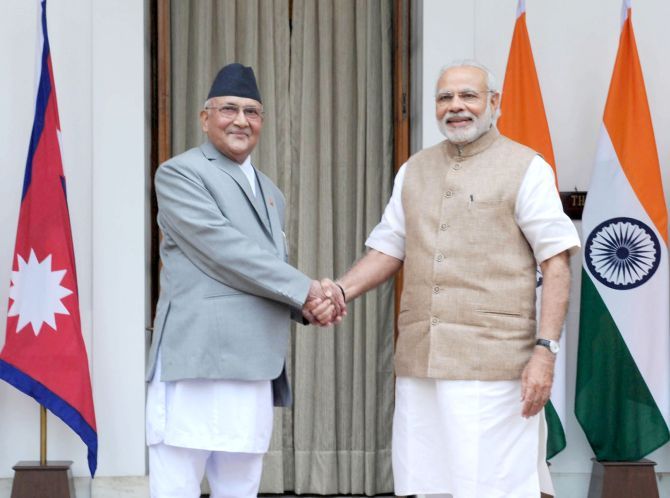 | « Back to article | Print this article |

India's unpopularity coincides with China lengthening its shadows in Nepal, says Rajeev Sharma.
The Narendra Modi government's Nepal policy is in tatters.
Nepal is the only South Asian country Modi has visited twice. He was keen on paying a third visit on May 21 to Lumbini on Buddh Purnima, but the K P Sharma Oli government scuttled it.
Relations between the Modi government and the Oli government were never warm since the latter came to power last October. Today the relations are frosty, belying the weather in the two countries. So much so that India-Nepal relations are far worse today than they were when the Modi government assumed office two years ago.
Some recent developments have triggered major reversals, seen rarely in India-Nepal affairs. First, the Oli government abruptly called off President Bidhya Devi Bhandari's visit to India, which was cleared by Nepal's envoy in India Deep Kumar Upadhyay. President Bhandari was scheduled to begin her India visit on May 9.
Then, the Oli government took the unprecedented decision of recalling its India envoy who dug in his boots in New Delhi even after he was sacked and declared his intention to join politics to square up against the Oli government. Upadhyay said he has no written or oral instructions from Kathmandu and he continues to be Nepal's ambassador to India. He returned to Kathmandu May 15, ten days after he was recalled.
Even before the controversy surrounding Upadhyay could die out, another controversy started simmering as reports came in that the Oli government was considering declaring India's ambassador in Kathmandu, Ranjit Rae, persona non grata for his alleged sins of omission and commission in toppling the Oli government.
Kamal Thapa, Nepal's deputy prime minister and foreign minister, rubbished these reports, but the very fact that such reports emerged in the Indian media means the matter can't be taken lightly.
Irrespective of whether the Oli government is planning to expel Rae -- an event unheard of in the history of India-Nepal relations -- one thing is sure: India's popularity in Nepal has been nose-diving ever since the Madhesi agitation started nine months ago and was called off four months later.
This is something I saw during my visit to Kathmandu and several Madhesi cities at the peak of the agitation last year. Modi did not polarise only Indian voters during the April-May 2014 Indian general election, he unwittingly polarised the Nepalese as well on the lines of hills versus plains.
While the plains people of Nepal -- broadly speaking, the Madhesis -- look upon Modi as their saviour, the hills people of Nepal demonise him and hold him responsible for all the problems currently plaguing their country.
Whatever may be the truth in the cloak-and-dagger story that the Oli government has been spinning -- accusing the Modi government of trying to topple it -- the blunt truth is that India is fast losing the perception battle among the Nepalese. To rub salt in India's wounds India's unpopularity coincides with China lengthening its shadows in Nepal.
Since the Modi government's advent in India, China has pipped India in the quantum of developmental aid to Nepal. India is out of the top five donors' list in Nepal.
Nepal's latest official data shows that in 2014-2015, India's official development assistance to Nepal saw a dip of over 50 per cent which allowed China to go past India. During this period Indian developmental aid to Nepal shrunk to slightly over $22 million, Chinese aid to Nepal was almost $38 million during this period.
India's ministry of external affairs has rubbished these statistics and said Indian developmental assistance to Nepal continues to be between $50 million and $60 million per annum.
For long, some observers have been predicting the rise of the Chinese influence in Nepal at India's expense. These forecasts are coming true. The development aid statistics prove this. The political turbulence in India-Nepal ties boosts this impression.
It is no mere coincidence that the latest political problems between India and Nepal surfaced on the heels of Oli's China visit.
The slugfest between India and Nepal shows that Modi's foreign policy, particularly in India's immediate neighbourhood, has come to nought. The Nepalese developments have added one more country in the Indian list of problem neighbours.
Thus far, only Pakistan and China figured in this dubious list, while tiny Maldives gave New Delhi goosebumps. Nepal now joins this list.
The Modi government needs to take corrective measures about Nepal. After all, India and Nepal share nearly 1,800 kilometres of open border.
Rajeev Sharma, an independent journalist and strategic columnist, tweets @Kishkindha